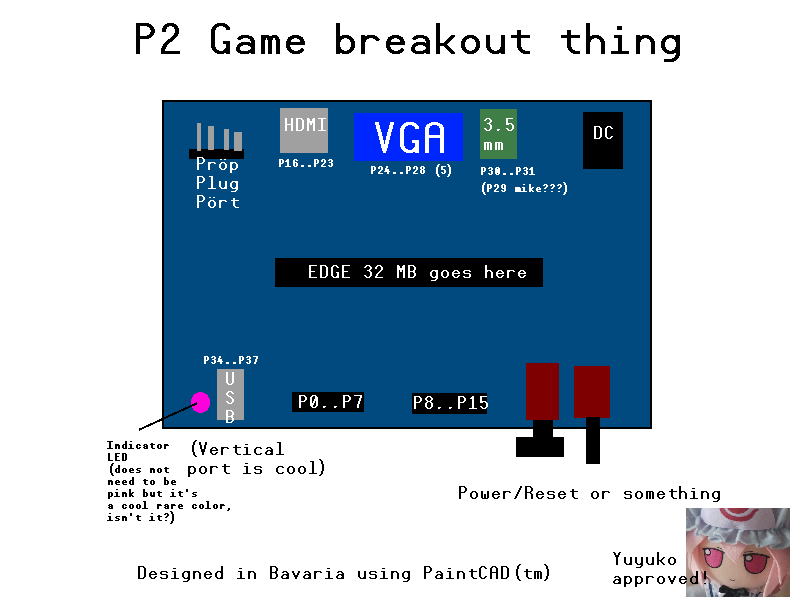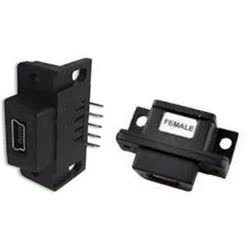P2EDGE gaming/standalone breakout
 Wuerfel_21
Posts: 5,745
Wuerfel_21
Posts: 5,745
This has... emerged... during live forum.

@VonSzarvas @"Ken Gracey" can finish this in 5 minutes and start to sell immediately. No need to thank me, I'm the ideas PCB designer.
But seriously... I think something along + P2EC-32MB would be approaching the lowest possible cost setup?


Comments
We hereby announce the formal release of AdaSpiel! How is the international "ring" to that name?
Ken Gracey
That's some extraordinary design skill
It sounds mildy silly to me as a native speaker, but all things of this nature do.
I'll come up with some names to choose from. You can too! Maybe this will materialize. - Ken
How about the “AdaPTiV Gaming Board”
I’ll see myself out.
Very handy carrier board for emulator and general uses. If not already discussed, I would suggest P29 be something wired into the 3.5mm socket for use with an optional 4 wire TRRS type of plug. That way you could potentially use this socket for AV out as well, or for digital SPDIF + analog audio use, or digital SPDIF + S-Video etc. You could still hook it up for external microphone use if desired too.
As to the other unused two pins, attaching them to a small Stemma/Qwiic JST SH 4 pin socket might be nice too, and that would allow the P2 a connection to a large range of i2c sensor/display boards as well while still keeping the lower 16 IO pins free for other double wide expansion boards to experiment with, eg, network, more memory/storage or other GPIO. You could also share these expansion i2c signals with on board LEDs too with buffering if desired. Having i2c should also allow Wii style controllers to be connected to the P2.
Maybe bring out the RAM pins too, in case someone would use a normal Edge.
32MB Edge does not care if the socket is wired to pins
Mike
That's great!
Just in case, sometimes ago I posted this:
https://forums.parallax.com/discussion/comment/1539114#Comment_1539114
That was before the usb hub support, now the USB ports can be connected to an on-board hub.
A simple and effective solution... Now we need someone that can make a PCB project out of this conception.
Not seen the YT replay yet, but isn't that achieving the same as the new P2 breakout with existing accessories attached?
Maybe cut a funky shaped piece of plywood or pvc and screw the pcbs down to make a permanent game board?
I'm also wondering if the dual header would allow the sort of fast memory expansion needed for gfx apps?
On the other side of the fence, perhaps such a simple addon/breakout would be a good (and quick) interim step, to test the water for a more optimised board with embedded P2 later.
Looking forward to watching all the chat and ideas!
Yea, I was on that, too, but I think it may not be worth it:
- Hub driver is currently mildly unstable and not being able to re-plug it is kinda a downer to that
- Would prevent using devices with inbuilt hubs
- The hub ICs (+ support components) seem to cost more than just buying a cheap hub
That's the point. The accessory boards are janky and awfully expensive as single SKUs. The specs I sketched are deliberately minimal to hopefully decrease cost.
No, but that's why the 32 MB Edge would be used. 32 is sufficient and the bandwidth on the 16 bit bus is great. If AP ever comes out with the 128Mbit chips I guess you could upgrade the edges themselves to 64MB.
BTW this discussion happened mostly after the recording stopped.
I have 3-d printed this:
The plan is to put EC-32 inside, and the P1 to service the keyboard matrix. The MIDI ports are visible here; on the right side there are 2 DB9 for joysticks, on the back there is DB15 for VGA, a cheap HDMI breakout board from Adafruit, audio jacks and a programming device.
And no time to connect all of these together (the keyboard matrix is made of mechanical switches inserted in a 3D-printed plate: this wil need several hours of soldering the matrix.
I think you're missing the point that some people just want to write code, while keepin things neat and tidy. This isn't limited to gaming, in fact, it provides a platform for Chip's goal of having a stand-alone P2 computer.
P2 accessories could be connected as well. I recently ordered 12 custom P2 accessory type boards for P2 and P1 (a made a P1 Eval board) development. This idea with a breadboard add-on would be a great lab for experimenters and schools.
Don't be alarmed I'm not missing any points here - just putting forward different perspectives and ideas to make sure we get to the best solution.
I'm not missing any points here - just putting forward different perspectives and ideas to make sure we get to the best solution.
Over time you might realise that I'm not always in favor of things I ask about- but ask anyway to test the water or to get answers for others. I always remain very open to change, and always appreciate and try to be considerate to everyone's kind ideas, especially as I'm just a small part of this community.
Sharing some info... "Gaming" capable boards have been proposed and designed internally many times over the last few years; some as breakout designs and others as P2 embedded designs. And I'm a big believer that such a platform would be a great way (and much simpler way) to get P2 used in more places, by having a solid platform that's simple to hookup, including video, audio, usb, servo-style and tough IO among other things. ie. I totally agree calling it a gaming board doesn't cover half the use cases, but could be a marketing thing and perhaps a good way to attract new talent and code contributors. Heck - I would have used such a board in projects a few times myself in the last years!
Sometimes we wait for the right moment for all manner of invisible reasons that others are in a position to decide- $$$- maybe the time is now that the cogs fit together.
In current thinking I wouldn't call it a gaming board though, but something that is marketable to both gaming and system builder worlds. P2 Edge Explorer was one product considered for that role, and seems about the same as the above, but with the qwiic header and a couple leds & push buttons, plus a little proto area for the (un)-used IOs. Another name / concept was the Propeller Maker Board, although that accepted either a FLiP or P2 module and had a baggie of solder-on parts/headers, so a little different. QuickStart 2 was another that might fit the compact, neat and tidy camp, although such a small board by itself turns out is not entirely performant and also needs add-ons. I thought I saw an Eval shape board that you'd also proposed at some point, and others have too. From all the good ideas there must be a common thread to make something as close to collectively ideal as possible.
So I do get that people just want to write code (me too somedays), and effort does go into making boards that are simpler for that, and capable of inspiring projects & products. But ultimately there's a business cost to release those things, so I try to be pragmatic and use the tools we have available- which today seems like the P2 Breakout board and accessories that are ready-to-go, and could be screwed to a base-plate to make a permanent sculpture, that some may deem neat and tidy or at least good for purpose to begin with.
In the end for sure though, the lessons learned (proven designs) from the add-ons, with code drivers developed, should be moved into a couple more task specific, compact boards. They might be breakouts for Edge modules, or where required P2 embed designs. Time will tell if that time is now, but for sure we will get there. And no doubt helped as Chip's stand-alone concept matures and the hardware needs become locked down.
So please don't be alarmed, and please keep on pushing for the boards and support you and the community needs. P2 is growing and the tools must keep moving too. For my part, I definitely hear and appreciate your points.
I like the breadboard addon.
We made one of those dual breadboards for the original P2 accessory pack, but then released the large prototype board add-on instead, as that is designed to accept the same mini breadboard and the headers around it, but also gives the option as a protoboard. Obviously using the single header instead of the dual could reduce size and I/O (and $) cost too.
https://www.parallax.com/product/p2-es-eval-protoboard-add-on/
Especially for customers that will make use of 16 IOs on the mini breadboard, I think your dual design is a bit neater than two singles. Although the two singles gets you more breadboard space. Pros/Cons as always! I wonder which would be more useful in practice. And you just gave me a great idea for another QuickByte article-- to demonstrate adding the mini-breadboard to the prototype add-on. Parallax should offer that as a kit !
There has been a big business cost to Parallax sitting still, and not really developing products and libraries for the chips you produce (e.g., you have a P2 uSD accessory board but no library or demo code to use it). Expecting your customers to pick up that load has not helped the P2 into the position it should occupy against other microcontrollers.
I don't disagree.
Yea, I just call it "gaming" because that's my brainrot. At the end of the day it's just button inputs and AV outputs that can be used for all sorts of interesting things. Including the elusive standalone system, but that's vaporware, you can't call it that. ;3 Well, maybe running emulated games off the SD card is enough to qualify as "standalone". On the other hand, in history, it's always the platforms that have games that win out. Amiga died because it didn't have Doom.
If we can make easy-to-use GUI libraries, some people might choose it over a Pi for some applications just to not have to deal with setting up a kiosk'd Linux. The grounds-up programming you do on P2 also mostly stops your embedded application from having any unforseen functionality (say, ability to load drivers for arbitrary USB devices when it really only needs to read a keyboard (and even if the keyboard is hardwired, did you remember to disable all kernel key commands?)).
WiFi enabled, HDMI capable and USB bedazzled P2 with a lightweight web browser -- that would be pretty cool
Maybe add a socket for an ESP-01. One of the accessory boards I created for myself does that, but it would be nice to have a socket built into the board and not consume either of the user IO headers.
It probably makes sense to align the USB pins with the USB host accessory board, which has 1st port at Base+2 and +3, a led at +0 and enable at +1. Essentially the USB in the diagram would be on 32..35, with 32 being a led that could be used for debugging.
Hi
in my opinion, an USB-Serial converter chip would make a lot of sense for this breakout-breakout. Such board is for programmers, not for game players. So you need the interface. I don't understand, why Parallax products don't come with it, as this is a clear disadvantage against the competitors. Obviously these chips cost very much less to the board manufacturer than a PropPlug. Perhaps you can add a scratch-off-jumper, if there is anyone, who really needs the bare serial connection. (I always wonder, in which direction should I plug in my PropPlug and I am very thankful, that up to now, there was no damage by this.)
Christof
+1
I am generally skeptical of having a usb>serial converter included in a basic, super stripped down, cost savvy boards. However, in this case, I am with Christof 100%.
The cost of the P2 Edge-32MB alone will make this combo expensive enough to swallow the tiny increase caused by the presence of the usb>uart converter chip.
Probably a good idea, yea. Though we'd still need a separate power input, normal USB data ports don't have enough juice.
The EU is pushing the USB-C as the required/universal plug for all rechargable devices, maybe an USB-C connector can double as serial adapter and power source (provided the serial adapter negotiate the required power) ?
I was also going to suggest a board with JAMMA connector but I think it is too specialized for the intended target.
Hopefully the big push of USB-C will see the price come down too. Would be neat to see USB-C becoming an option.
USB-C doesn't solve the power issue though. The upstream USB-A port on the PC doesn't know or care. Only if it's a C to C connection would USB-PD work.
There is this thing: https://www.mouser.pl/ProductDetail/FTDI/DB9-USB-D3-F?qs=ANJC8C65Mw4DXU1z8qsPNA==
It has an outdated Mini USB connector, but it can be used as a P2 programmer (tested ) - maybe they will switch to USB C connector in the future. DB9 style connector fits with a retrocomputing device
) - maybe they will switch to USB C connector in the future. DB9 style connector fits with a retrocomputing device 

Miss me with miniUSB. Stupid connector.
How about leaving out the stupid USB connector and instead fitting a stupid regular 2.54mm spaced header pins/socket ?
You cut the whatever cable you have, fit it with the appropriate ending and off you go. Just a thought.